Alfa Romeo Giulia 2019 Owner's Manual
Manufacturer: ALFA ROMEO, Model Year: 2019, Model line: Giulia, Model: Alfa Romeo Giulia 2019Pages: 232, PDF Size: 4.87 MB
Page 181 of 232
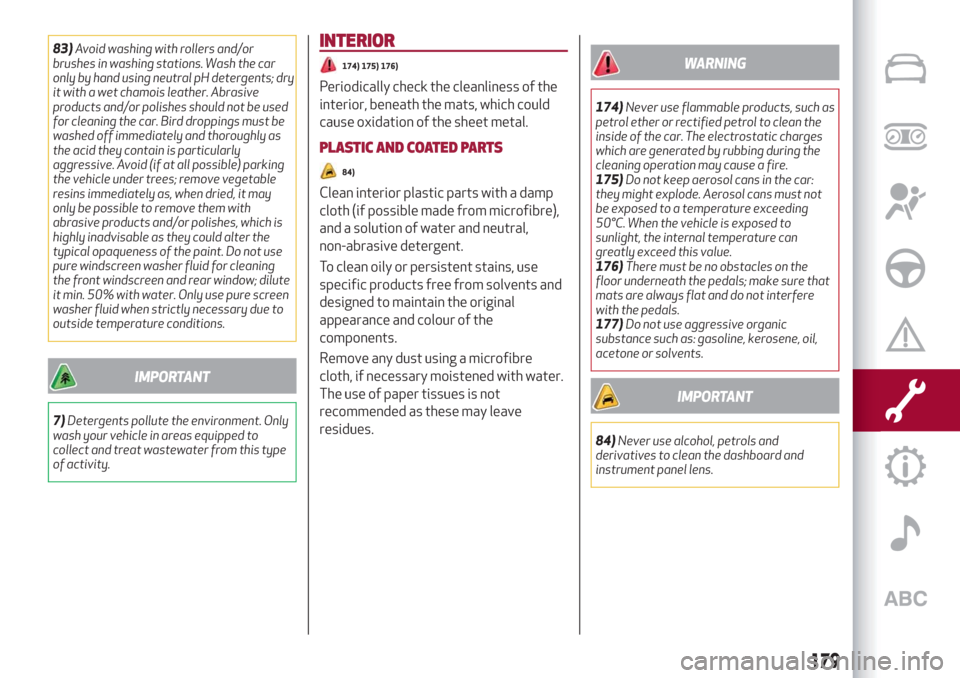
83)Avoid washing with rollers and/or
brushes in washing stations. Wash the car
only by hand using neutral pH detergents; dry
it with a wet chamois leather. Abrasive
products and/or polishes should not be used
for cleaning the car. Bird droppings must be
washed off immediately and thoroughly as
the acid they contain is particularly
aggressive. Avoid (if at all possible) parking
the vehicle under trees; remove vegetable
resins immediately as, when dried, it may
only be possible to remove them with
abrasive products and/or polishes, which is
highly inadvisable as they could alter the
typical opaqueness of the paint. Do not use
pure windscreen washer fluid for cleaning
the front windscreen and rear window; dilute
it min. 50% with water. Only use pure screen
washer fluid when strictly necessary due to
outside temperature conditions.
IMPORTANT
7)Detergents pollute the environment. Only
wash your vehicle in areas equipped to
collect and treat wastewater from this type
of activity.
INTERIOR
174) 175) 176)
Periodically check the cleanliness of the
interior, beneath the mats, which could
cause oxidation of the sheet metal.
PLASTIC AND COATED PARTS
84)
Clean interior plastic parts with a damp
cloth (if possible made from microfibre),
and a solution of water and neutral,
non-abrasive detergent.
To clean oily or persistent stains, use
specific products free from solvents and
designed to maintain the original
appearance and colour of the
components.
Remove any dust using a microfibre
cloth, if necessary moistened with water.
The use of paper tissues is not
recommended as these may leave
residues.
WARNING
174)Never use flammable products, such as
petrol ether or rectified petrol to clean the
inside of the car. The electrostatic charges
which are generated by rubbing during the
cleaning operation may cause a fire.
175)Do not keep aerosol cans in the car:
they might explode. Aerosol cans must not
be exposed to a temperature exceeding
50°C. When the vehicle is exposed to
sunlight, the internal temperature can
greatly exceed this value.
176)There must be no obstacles on the
floor underneath the pedals; make sure that
mats are always flat and do not interfere
with the pedals.
177)Do not use aggressive organic
substance such as: gasoline, kerosene, oil,
acetone or solvents.
IMPORTANT
84)Never use alcohol, petrols and
derivatives to clean the dashboard and
instrument panel lens.
179
Page 182 of 232

This page is intentionally left blank
Page 183 of 232
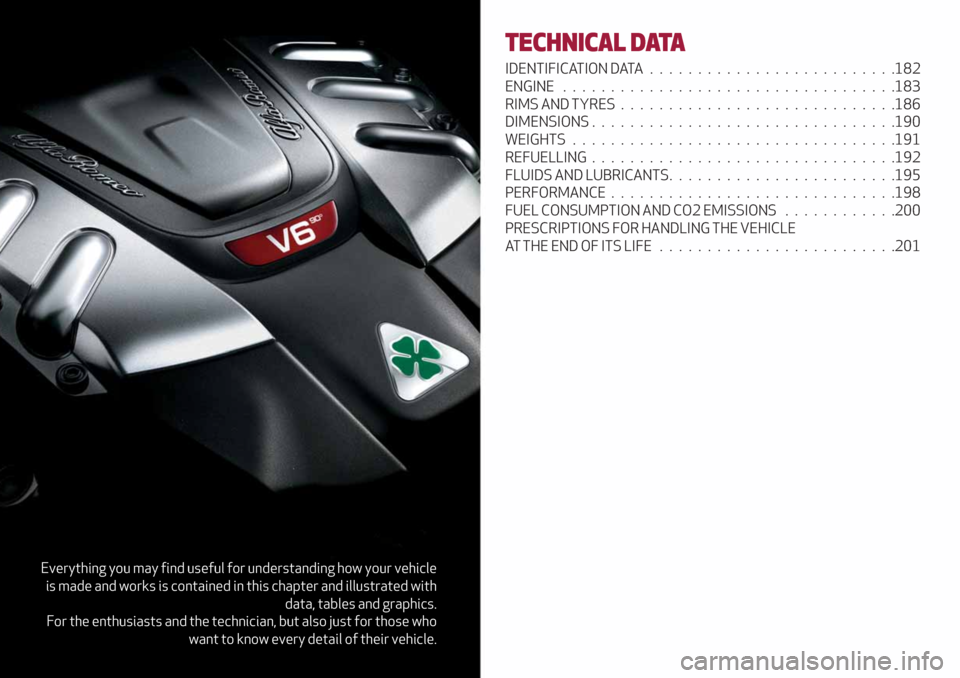
Everything you may find useful for understanding how your vehicle
is made and works is contained in this chapter and illustrated with
data, tables and graphics.
For the enthusiasts and the technician, but also just for those who
want to know every detail of their vehicle.
TECHNICAL DATA
IDENTIFICATION DATA..........................182
ENGINE...................................183
RIMS AND TYRES.............................186
DIMENSIONS . . ..............................190
WEIGHTS..................................191
REFUELLING................................192
FLUIDS AND LUBRICANTS........................195
PERFORMANCE..............................198
FUEL CONSUMPTION AND CO2 EMISSIONS . . ..........200
PRESCRIPTIONS FOR HANDLING THE VEHICLE
AT THE END OF ITS LIFE.........................201
Page 184 of 232
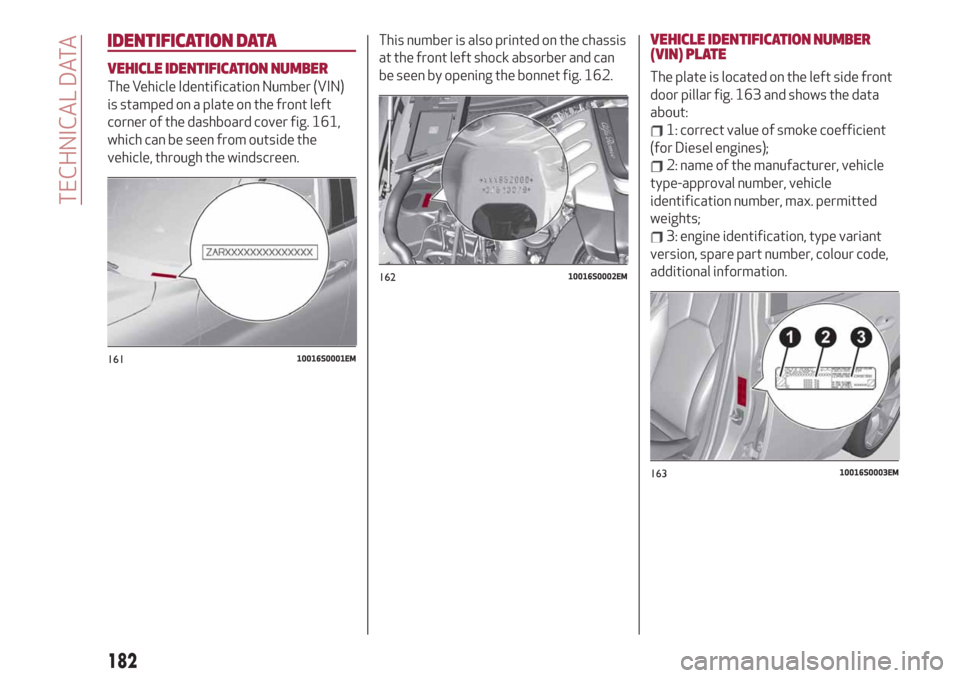
IDENTIFICATION DATA
VEHICLE IDENTIFICATION NUMBER
The Vehicle Identification Number (VIN)
is stamped on a plate on the front left
corner of the dashboard cover fig. 161,
which can be seen from outside the
vehicle, through the windscreen.This number is also printed on the chassis
at the front left shock absorber and can
be seen by opening the bonnet fig. 162.
VEHICLE IDENTIFICATION NUMBER
(VIN) PLATE
The plate is located on the left side front
door pillar fig. 163 and shows the data
about:
1: correct value of smoke coefficient
(for Diesel engines);
2: name of the manufacturer, vehicle
type-approval number, vehicle
identification number, max. permitted
weights;
3: engine identification, type variant
version, spare part number, colour code,
additional information.
16110016S0001EM
16210016S0002EM
16310016S0003EM
182
TECHNICAL DATA
Page 185 of 232
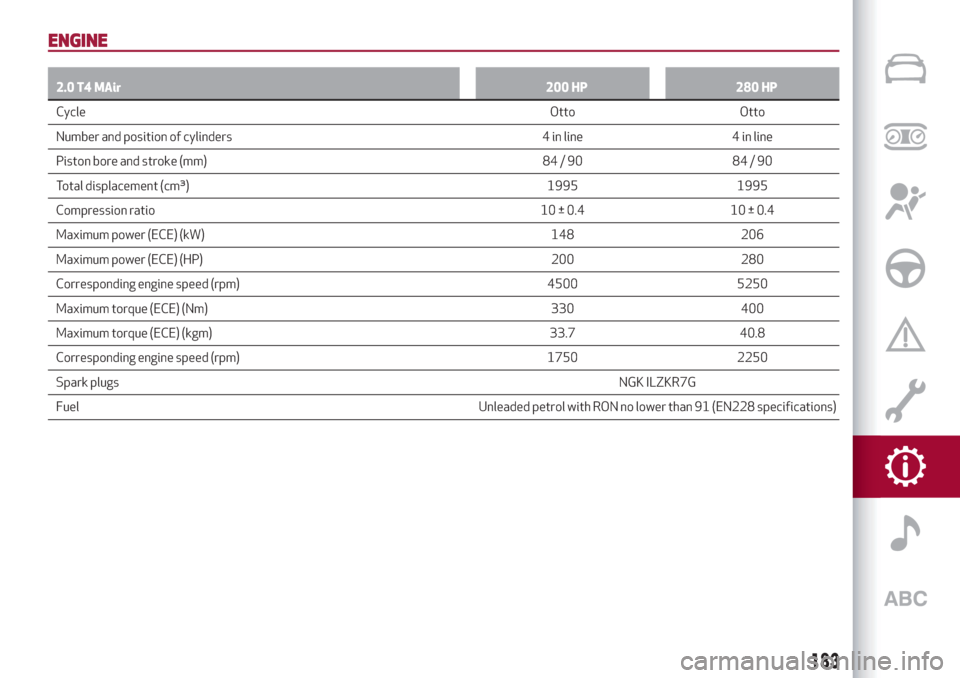
ENGINE
2.0 T4 MAir200 HP 280 HP
CycleOtto
Otto
Number and position of cylinders 4 in line 4 in line
Piston bore and stroke (mm) 84 / 90 84 / 90
Total displacement (cm³) 1995 1995
Compression ratio 10 ± 0.4 10 ± 0.4
Maximum power (ECE) (kW) 148 206
Maximum power (ECE) (HP) 200 280
Corresponding engine speed (rpm) 4500 5250
Maximum torque (ECE) (Nm) 330 400
Maximum torque (ECE) (kgm) 33.7 40.8
Corresponding engine speed (rpm) 1750 2250
Spark plugsNGK ILZKR7G
Fuel Unleaded petrol with RON no lower than 91 (EN228 specifications)
183
Page 186 of 232
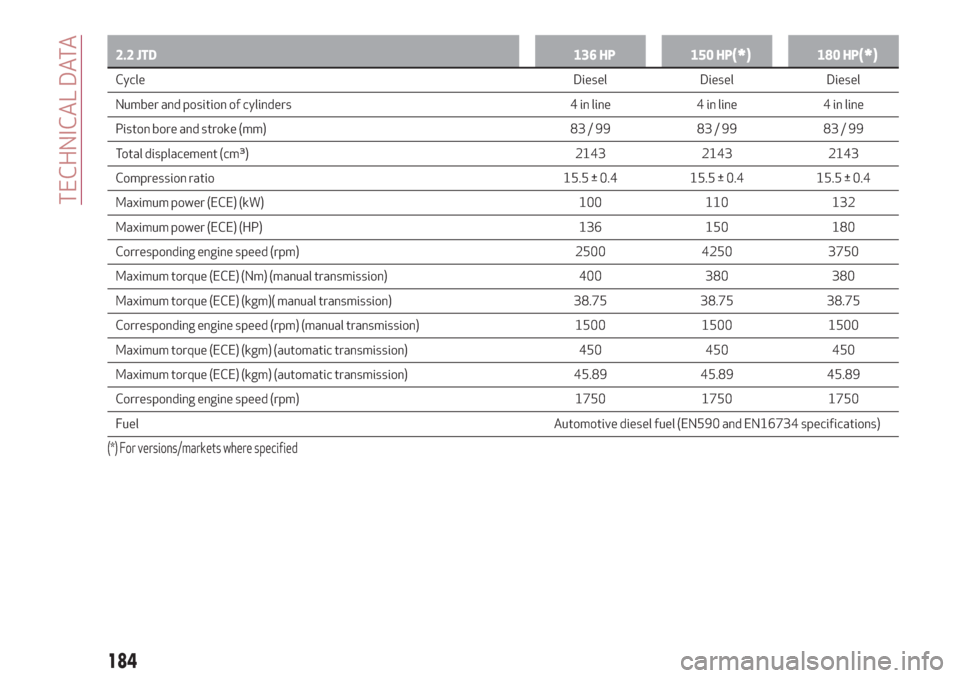
2.2 JTD136 HP 150 HP(*)180 HP(*)
CycleDiesel Diesel Diesel
Number and position of cylinders 4 in line 4 in line 4 in line
Piston bore and stroke (mm) 83 / 99 83 / 99 83 / 99
Total displacement (cm³) 2143 2143 2143
Compression ratio 15.5 ± 0.4 15.5 ± 0.4 15.5 ± 0.4
Maximum power (ECE) (kW) 100 110 132
Maximum power (ECE) (HP) 136 150 180
Corresponding engine speed (rpm) 2500 4250 3750
Maximum torque (ECE) (Nm) (manual transmission) 400 380 380
Maximum torque (ECE) (kgm)( manual transmission) 38.75 38.75 38.75
Corresponding engine speed (rpm) (manual transmission) 1500 1500 1500
Maximum torque (ECE) (kgm) (automatic transmission) 450 450 450
Maximum torque (ECE) (kgm) (automatic transmission) 45.89 45.89 45.89
Corresponding engine speed (rpm) 1750 1750 1750
FuelAutomotive diesel fuel (EN590 and EN16734 specifications)
(*) For versions/markets where specified
184
TECHNICAL DATA
Page 187 of 232
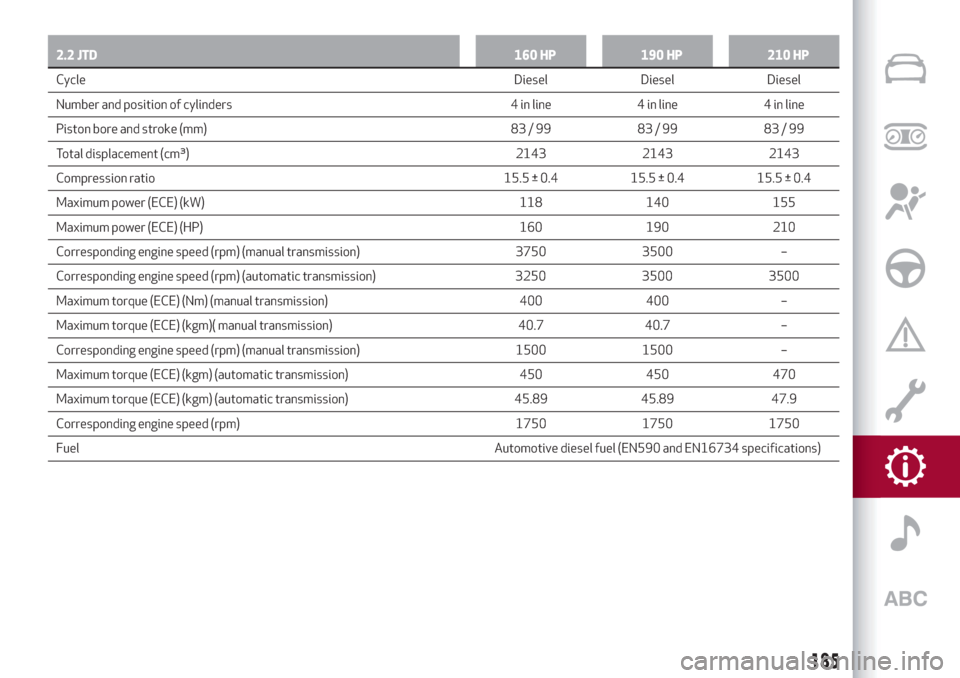
2.2 JTD160 HP 190 HP 210 HP
CycleDiesel Diesel Diesel
Number and position of cylinders 4 in line 4 in line 4 in line
Piston bore and stroke (mm) 83 / 99 83 / 99 83 / 99
Total displacement (cm³) 2143 2143 2143
Compression ratio 15.5 ± 0.4 15.5 ± 0.4 15.5 ± 0.4
Maximum power (ECE) (kW) 118 140 155
Maximum power (ECE) (HP) 160 190 210
Corresponding engine speed (rpm) (manual transmission) 3750 3500 –
Corresponding engine speed (rpm) (automatic transmission) 3250 3500 3500
Maximum torque (ECE) (Nm) (manual transmission) 400 400 –
Maximum torque (ECE) (kgm)( manual transmission) 40.7 40.7 –
Corresponding engine speed (rpm) (manual transmission) 1500 1500 –
Maximum torque (ECE) (kgm) (automatic transmission) 450 450 470
Maximum torque (ECE) (kgm) (automatic transmission) 45.89 45.89 47.9
Corresponding engine speed (rpm) 1750 1750 1750
FuelAutomotive diesel fuel (EN590 and EN16734 specifications)
185
Page 188 of 232
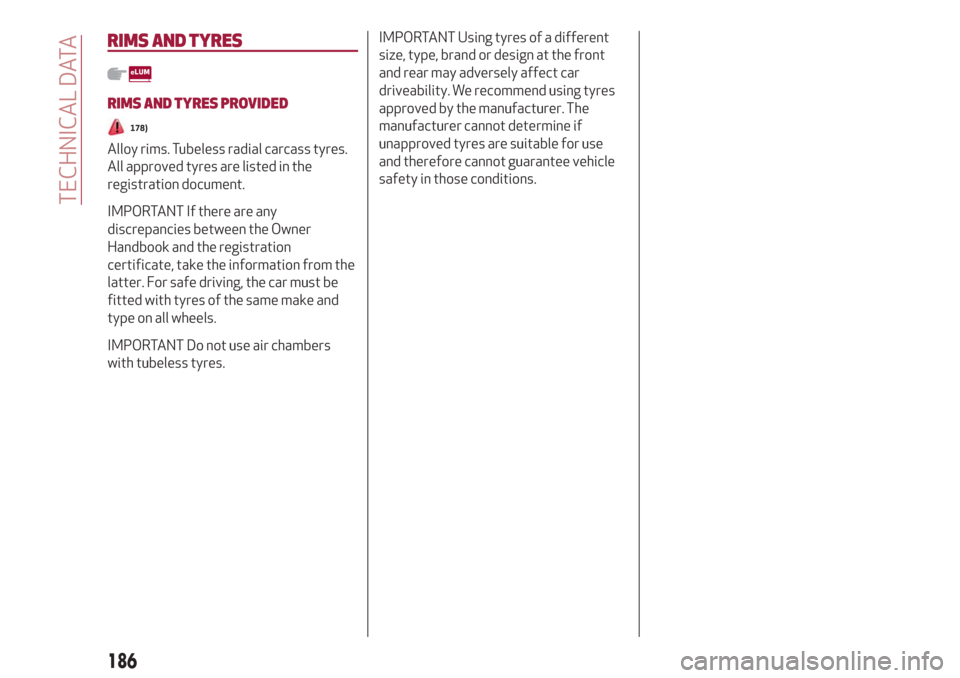
RIMS AND TYRES
RIMS AND TYRES PROVIDED
178)
Alloy rims. Tubeless radial carcass tyres.
All approved tyres are listed in the
registration document.
IMPORTANT If there are any
discrepancies between the Owner
Handbook and the registration
certificate, take the information from the
latter. For safe driving, the car must be
fitted with tyres of the same make and
type on all wheels.
IMPORTANT Do not use air chambers
with tubeless tyres.IMPORTANT Using tyres of a different
size, type, brand or design at the front
and rear may adversely affect car
driveability. We recommend using tyres
approved by the manufacturer. The
manufacturer cannot determine if
unapproved tyres are suitable for use
and therefore cannot guarantee vehicle
safety in those conditions.
186
TECHNICAL DATA
Page 189 of 232
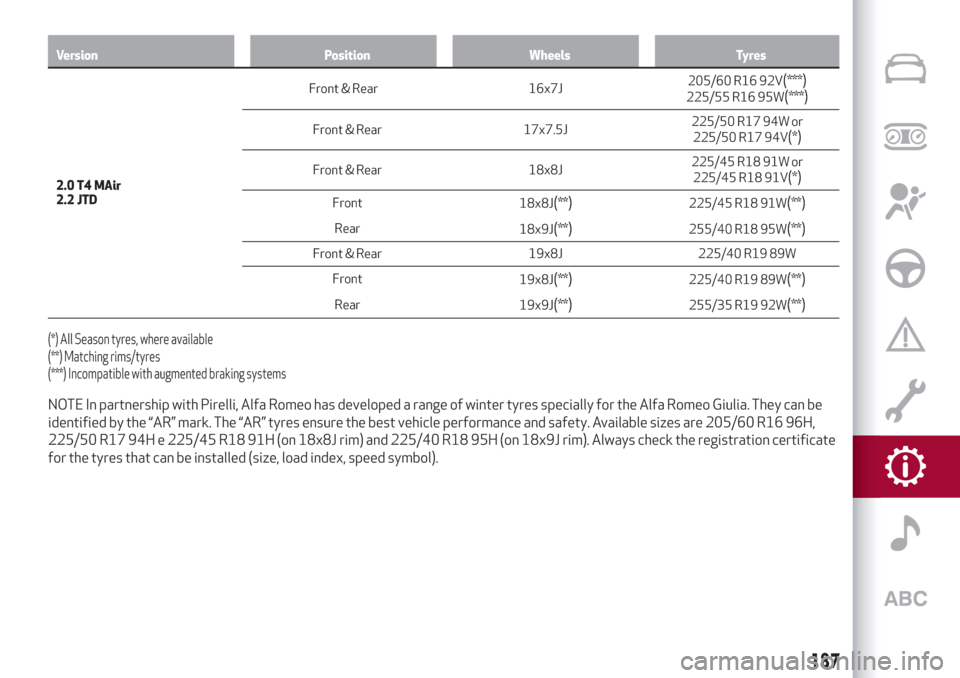
Version Position Wheels Tyres
2.0 T4 MAir
2.2 JTDFront & Rear 16x7J205/60 R16 92V
(***)225/55 R16 95W(***)
Front & Rear 17x7.5J225/50 R17 94W or
225/50 R17 94V(*)
Front & Rear 18x8J225/45 R18 91W or
225/45 R18 91V(*)
Front
18x8J(**)225/45 R18 91W(**)
Rear
18x9J(**)255/40 R18 95W(**)
Front & Rear 19x8J 225/40 R19 89W
Front
19x8J
(**)225/40 R19 89W(**)
Rear
19x9J(**)255/35 R19 92W(**)
(***) Incompatible with augmented braking systems (*) All Season tyres, where available
(**) Matching rims/tyres
NOTE In partnership with Pirelli, Alfa Romeo has developed a range of winter tyres specially for the Alfa Romeo Giulia. They can be
identified by the “AR” mark. The “AR” tyres ensure the best vehicle performance and safety. Available sizes are 205/60 R16 96H,
225/50 R17 94H e 225/45 R18 91H (on 18x8J rim) and 225/40 R18 95H (on 18x9J rim). Always check the registration certificate
for the tyres that can be installed (size, load index, speed symbol).
187
Page 190 of 232
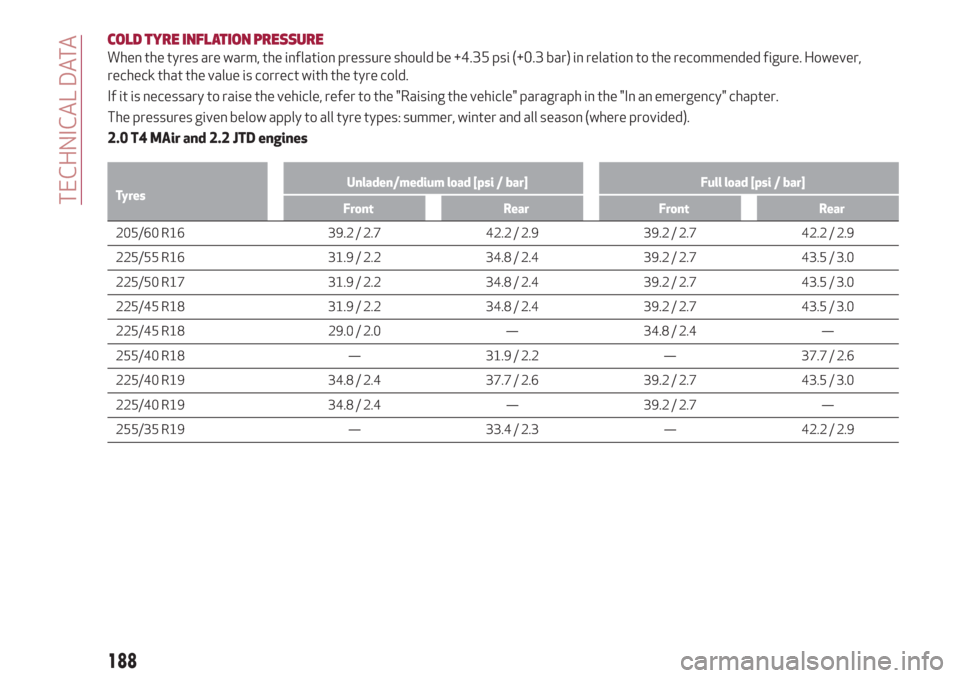
COLD TYRE INFLATION PRESSURE
When the tyres are warm, the inflation pressure should be +4.35 psi (+0.3 bar) in relation to the recommended figure. However,
recheck that the value is correct with the tyre cold.
If it is necessary to raise the vehicle, refer to the "Raising the vehicle" paragraph in the "In an emergency" chapter.
The pressures given below apply to all tyre types: summer, winter and all season (where provided).
2.0 T4 MAir and 2.2 JTD engines
TyresUnladen/medium load [psi / bar] Full load [psi / bar]
Front Rear Front Rear
205/60 R16 39.2 / 2.7 42.2 / 2.9 39.2 / 2.7 42.2 / 2.9
225/55
R16 31.9 / 2.2 34.8 / 2.4 39.2 / 2.7 43.5 / 3.0
225/50 R17 31.9 / 2.2 34.8 / 2.4 39.2 / 2.7 43.5 / 3.0
225/45 R18 31.9 / 2.2 34.8 / 2.4 39.2 / 2.7 43.5 / 3.0
225/45 R18 29.0 / 2.0 — 34.8 / 2.4 —
255/40 R18 — 31.9 / 2.2 — 37.7 / 2.6
225/40 R19 34.8 / 2.4 37.7 / 2.6 39.2 / 2.7 43.5 / 3.0
225/40 R19 34.8 / 2.4 — 39.2 / 2.7 —
255/35 R19 — 33.4 / 2.3 — 42.2 / 2.9
188
TECHNICAL DATA